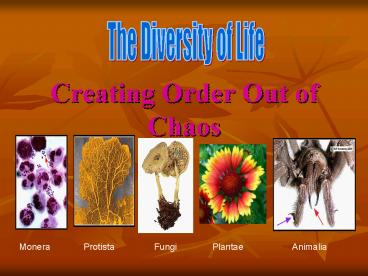Creating Order Out of Chaos - PowerPoint PPT Presentation
1 / 23
Title:
Creating Order Out of Chaos
Description:
Phylogeny is the system by which we show how species are related through evolution. ... And the rodents: rats, mice, squirrels, rabbits, prairie dogs, groundhogs etc. ... – PowerPoint PPT presentation
Number of Views:129
Avg rating:3.0/5.0
Title: Creating Order Out of Chaos
1
Creating Order Out of Chaos
The Diversity of Life
Monera
Protista
Fungi
Plantae
Animalia
2
Phylogeny
- Phylogeny is the system by which we show how
species are related through evolution. This is
also how we search for evidence of new species
evolving. - Before Darwin, Naturalists believed that species
were fixed created in their current form. - Therefore, classification was logical but
arbitrary.
3
Darwin and Phylogeny
- After Darwin, Biologists started making their
classifications look like a family tree through
which species were connected by nearest relatives
and common ancestors. - Taxonomists call these phylogenetic trees.
4
Cladistics
- Cladisticsgets its name because the branches on
the family tree are called clades. - Clades are taxa that are genetically related to
each other and to a common ancestor. - The district and the AIMS test use the terms
clades and taxa interchangeably.
5
How Many Species are There
- Today biologists have identified approximately
- 740,000 insect species
- 290,000 plants
- 23,000 algae
- 30,000 protozoa
- 66,000 fungi
- 4,600 monera
- 280,000 other animals, and thousands more are
added to this list every year. - The overall estimates are between 20 and 35
million!
6
Good Homologies
- The more constant a characteristic is the more
valuable it is for classification. - Write down 3 characteristics that would not be
good homologies and share them with your neighbor
to your right. - How do you think computers have helped to better
classify organisms. Share your answer with the
person on your left.
7
The Problem of Taxonomy
- http//www.brooklyn.cuny.edu/bc/ahp/CLAS/CLAS.Pre.
html - Come up with what you think is the best system
for organizing these shapes.
8
KPCOFGS
- King Phillip Came
- Over For Good
- Spaghetti
- Kingdom
- Phylum
- Class
- Order
- Family
- Genus
- Species
9
Kingdom
- The Kingdom is the highest rank in the biological
taxonomy of all organisms. - Monera
- Protista
- Fungi
- Plantae
- Animalia
10
Human Kingdom
- Humans are classified in the Kingdom Animalia.
- Members of the Kingdom Animalia are
- Heterotrophic
- Eukaryotic
- Multicellular
- Our embryos have a blastula stage
11
Blastula
- The blastula is when the zygote divides from the
single celled fusion of sperm and egg into the
multicellular organism that develops into the
embryo of an animal.
12
Phylum
- The phylum is the broadest category that tells us
about the genetic relationship of members of a
kingdom. - Monera Prokaryotic bacteria
- Protista Multicellular algae (red, green,
brown), slime molds - Fungi Lichens, Mushrooms, Yeast
- Plantae Monocots, Dicots, Sporophytes,
angiosperms, gymnosperms - Animalia Porifera, Arthropods, Molluscs,
Echinoderms, Chordates
13
Human Phylum
- Humans are members of the phylum chordata. This
means that we are distantly related to all
organisms with a backbone.
14
Chordata
- Chordata separates the animals with a notochord
from the arthropoda the animals with an
exo-skeleton which includes insects, arachnids
and crustaceans.
15
Chordate Features
- All chordates share the following features
- Pharyngeal slits - a series of openings that
connect the inside of the throat to the outside
of the "neck". These develop into gills in fish
and part of the inner ear in humans. - Dorsal nerve cord - a bundle of nerve fibers
which runs down the "back". It connects the brain
with the lateral muscles and other organs. - Notochord - cartilaginous rod running underneath,
and supporting, the nerve cord. - Post-anal tail - an extension of the body past
the anal opening.
16
Class
- Class tells us how closely related the different
phylum are related. - Humans are members of the class mammalia meaning
that we have hair, nurse our young and we are
endotherms (warm blooded). - This separates us from the other classes of
animals which include Aves, Reptilia and
Amphibia.
17
Order
- Orders tell us how closely related different
classes are genetically. - Humans are members of the order Primates. This
separates us from the carnivores lions and bears - And the rodents rats, mice, squirrels, rabbits,
prairie dogs, groundhogs etc.
18
Primate Characteristics
- Forward-facing eyes for binocular vision giving
us depth perception - Rely strongly on vision over other senses
- Color vision
- Opposable thumbs
- Grasping fingers
- Flattened nails to protect fingertips
19
Primate Characteristics
- Generalized teeth for omnivorous diet
- Expansion of the brainespecially the cerebral
cortex - Prolonged life
- Fewer offspring per litter
- Only one pair of mammary glands
- Complicated social organization
20
Family
- Families tell us how closely related different
orders are genetically. - The human family separates the different
primates - Humans are part of the family hominidae which
includes the great apes. - This group includes gibbons, orangutans,
gorillas, chimpanzees and humans
21
Genus
- The genus separates members of a family.
- Humans are members of the family Homo which means
man. - Modern humans are homo sapiens.
- All other members of the genus homo have gone
extinct.
22
Species
- Species is the finest distinction.
- Members of a species are unique and cannot have
viable young with other species. - Homo habilis
- Homo ergaster
- Homo erectus
- Homo neanderthalensis
- Homo sapien
- Homo sapien sapien
23
- http//www.geocities.com/RainForest/6243/diversity
.html - http//waynesword.palomar.edu/trfeb98.htm
- http//susdl.fcla.edu/lfnh/currmat/Taxonomy.html
- http//www.brooklyn.cuny.edu/bc/ahp/CLAS/CLAS.Dive
rsity.html - http//www.ucmp.berkeley.edu/chordata/chordata.htm
l - http//nationalzoo.si.edu/Animals/Primates/Facts/P
rimateness/default.cfm































